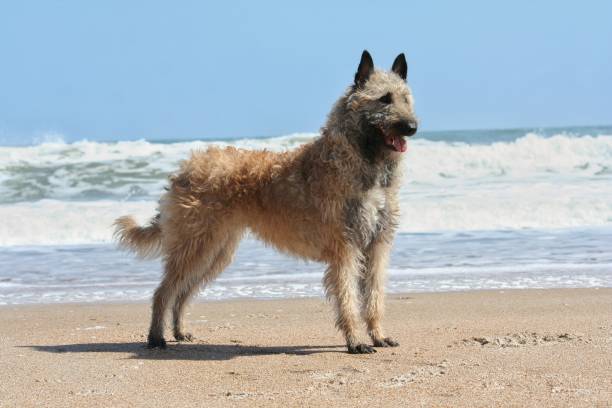Belgian Laekenois

Breed History:
The Belgian Laekenois is the rarest of the four varieties of Belgian Shepherds, developed in Belgium in the late 19th century. It is named after the royal castle of Laeken, where it was favoured by the Belgian royal family. Originally bred as a sheep herder and property guardian, the Laekenois distinguished itself from its counterparts by its distinctive rough, wiry coat.
Like the other Belgian Shepherds—Groenendael, Malinois, and Tervuren—the Laekenois shares the same breed standard except for coat type and colour. During World Wars I and II, it served as a messenger dog and military aide, showcasing its courage and loyalty. Although still relatively rare outside Belgium, the Laekenois is gaining recognition as a versatile working and companion dog.
|
Gender |
Height |
Weight |
|
Male |
60–66 cm |
25–30 kg |
|
Female |
56–62 cm |
20–25 kg |
Size – Medium-Large
Life Expectancy: 10–14 years

Breed Appearance:
The Belgian Laekenois has a sturdy, athletic build and a square silhouette typical of the Belgian Shepherd family. What sets it apart is its tousled, wiry coat that ranges in shades of fawn with traces of black, particularly around the muzzle and tail. The rough coat gives it a rustic, weather-resistant appearance well-suited to outdoor work.
Its expressive dark eyes, erect triangular ears, and confident stance convey alertness and intelligence. The Laekenois moves with a smooth, fluid gait that reflects its agility and working heritage. The coat's texture and colouration may appear unkempt, but it is a defining feature of the breed.
Breed Type – Family/Guard:
Originally a herding and guarding breed, the Belgian Laekenois retains strong protective instincts. It is loyal and watchful, forming tight bonds with its family while remaining reserved with strangers. Though affectionate and playful with those it trusts, it can be wary in unfamiliar situations.
This breed excels as a guardian and companion in active households. It thrives when given purpose, whether through herding tasks, obedience work, or dog sports. With proper training and socialisation, the Laekenois becomes a trustworthy and devoted member of the family.

Training:
The Belgian Laekenois is intelligent, alert, and eager to work. It responds well to consistent, reward-based training and thrives on mental challenges. Quick to learn, it can master obedience, agility, herding trials, and scent work when guided by a patient, experienced handler.
Due to its independent streak and sensitivity, training should be firm yet positive. Harsh methods may cause withdrawal or anxiety. Early and ongoing socialisation is crucial to develop confidence and ensure the dog is well-adjusted in various environments and around other animals.
Health & Care:
The Laekenois is generally healthy, but like all breeds, it can be predisposed to certain hereditary conditions. Health concerns include hip and elbow dysplasia, progressive retinal atrophy (PRA), and thyroid dysfunction. Responsible breeding and regular veterinary checkups are key to maintaining health.
Its rough coat is relatively low-maintenance but requires occasional grooming to prevent matting and remove debris. Weekly brushing and seasonal coat care are recommended. Balanced nutrition, regular exercise, vaccinations, and parasite prevention are essential to its overall well-being.

Living Conditions:
While adaptable, the Belgian Laekenois is best suited to homes where it can stay active and engaged. It does well in houses with a yard or access to open space, but can live in apartments if given ample daily exercise and interaction.
This breed is not ideal for sedentary lifestyles or owners who are away for long hours. Without regular activity and mental stimulation, it may develop behavioural issues like barking, digging, or destructive chewing. The Laekenois prefers cool climates and close companionship with its people.
Exercise:
The Belgian Laekenois is an energetic working breed that requires at least 1 to 2 hours of daily exercise. It enjoys running, herding games, obedience drills, and off-leash play in secure areas. Physical activity paired with mental challenges is essential to keep this breed content.
It thrives on structured routines and active engagement, such as puzzle toys, nose work, and agility courses. Inactive or under-stimulated Laekenois may become frustrated or restless, leading to undesirable behaviours. A tired Laekenois is a happy Laekenois.
Grooming:
Despite its shaggy look, the Laekenois’s rough coat is relatively easy to maintain. Weekly brushing with a slicker brush or grooming mitt keeps it free from tangles and loose hair. During seasonal shedding, more frequent grooming is needed.
Bathing should be infrequent to preserve the coat’s natural texture and weather resistance. Routine care includes regular nail trims, dental hygiene, and ear checks. After outdoor activities, check for burrs or ticks, particularly around the legs and tail.

Advantages:
- Intelligent, alert, and quick to learn
- Loyal and protective without being overly aggressive
- Distinctive coat with rustic charm and low odour
- Thrives in active, purpose-driven households
- Versatile working dog suited for herding, protection, and dog sports
- Affectionate and playful with its family
Disadvantages:
-
Rare breed; may be difficult to find from reputable breeders
- Needs significant daily exercise and mental enrichment
- Strong-willed; training requires experience and consistency
- Can become anxious or destructive if left bored or alone
-
Reserved with strangers; needs thorough early socialisation
- Coat requires regular brushing and occasional hand-stripping









